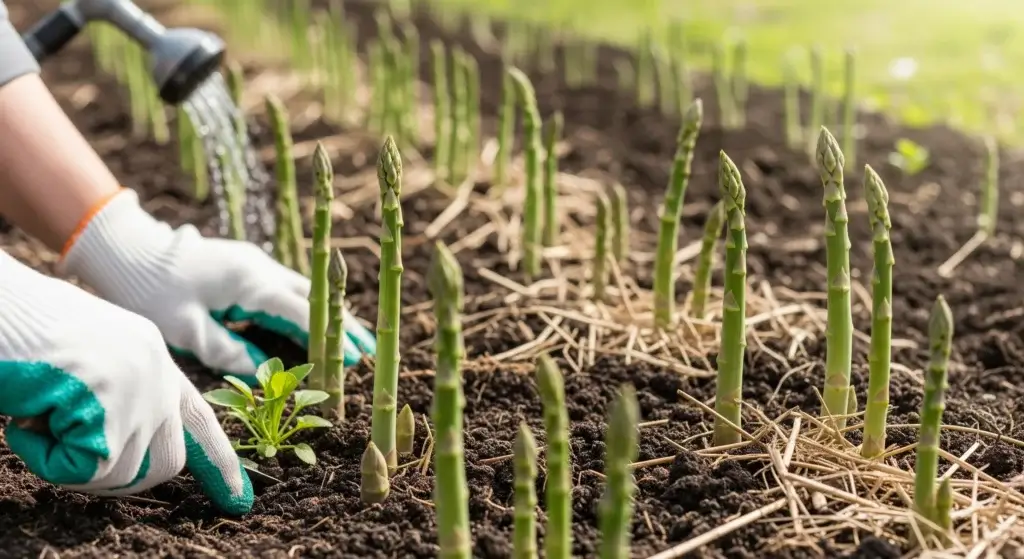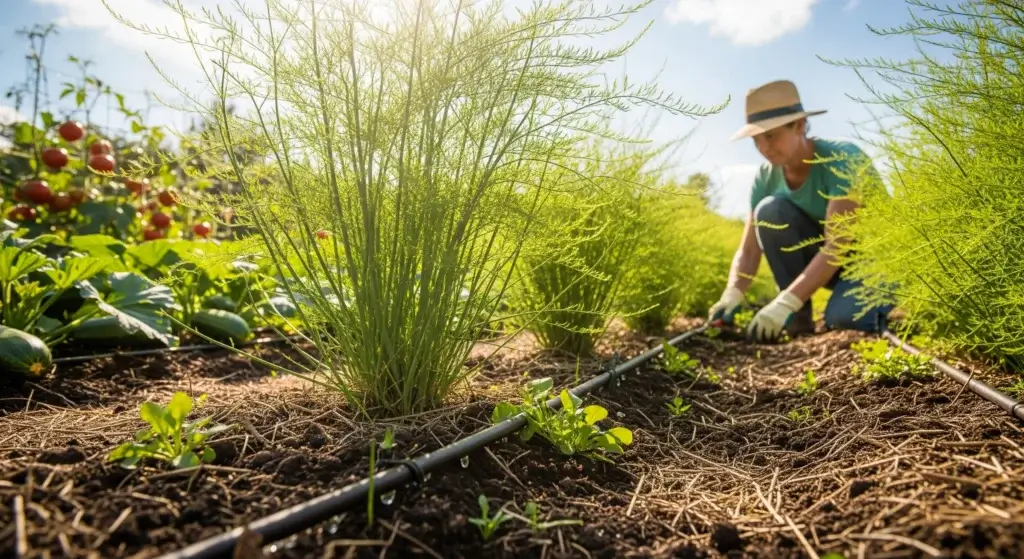
Hey there, fellow tomato enthusiasts!
Today, we’re diving deep into the world of tomato stems.
These slender, yet mighty, structures play a crucial role in the overall health and vitality of our beloved tomato plants.
But what happens when these stems encounter trouble?
Fear not, because we’re here to guide you through the ins and outs of troubleshooting common tomato stem problems.
The Importance of Tomato Stem for Plant Health
Support structure
From the moment a tiny seedling emerges from the soil, the stem serves as a sturdy pillar, bearing the weight of leaves, branches, and, eventually, the bounty of ripe tomatoes.
Just like a sturdy backbone supports the human body, tomato stems provide essential structural support to the entire plant.
Without strong and healthy stems, our tomato plants would collapse under their weight.
- Read also: Tomato Plant Watering Schedule
- Read also: Mastering the Art of Drip Irrigation for Tomatoes
Transportation system
Tomato stems act as the plant’s transportation network, efficiently moving water and vital nutrients from the roots to the rest of the plant.
Through a process called transpiration, water is absorbed by the roots and travels upward through the stem, reaching every leaf, flower, and fruit.
Defense system
Stems can harbor beneficial microorganisms that help defend against pests and diseases.
They may also produce physical barriers like thorns or waxy coatings to deter attackers.
Food production
Just like leaves, stems contain chlorophyll.
The green pigment is responsible for photosynthesis, but it is not a major site of photosynthesis.
This process converts sunlight, water, and carbon dioxide into sugars, the plant’s primary energy source.
So, stems actually contribute directly to food production within the plant.

What are Tomato Stem Problems?
Lumps and outgrowths
These abnormal growths on the stem can be caused by root initials, which occur when the plant is under stress or in humid conditions.
Root initials are the plant’s attempt to form roots on the stem to access water and nutrients.
Hormone weed killer contamination
Some weed killers contain hormones that can cause root initials to form on tomato stems.
This issue is more common when the weedkiller is applied incorrectly or when the tomato plants are too close to the treated area.
Sunscald
Sunscald, also known as sunburn, is a type of damage that can occur on the stems of plants, particularly young and thin-barked ones when they are exposed to intense sunlight for extended periods.
It’s similar to how humans get sunburned but on a plant scale.
Fungal diseases
Tomato plants can face various challenges, including a handful of notorious fungal diseases that target their stems.
Here are some common fungal diseases that may attack your tomato plants:
Tomato blight
This isn’t a single disease, but an umbrella term encompassing two major culprits:
- Early Blight (Alternaria solani)
Imagine brownish bulls-eye targets on leaves and stems.
This loves warm, humid weather and spreads easily. Look out for wilting, defoliation, and stunted fruit production.
- Late Blight (Phytophthora infestans)
This one is more aggressive, causing rapid wilting, brown lesions on leaves and stems, and gray, fuzzy mold on fruits.
Humid, cool weather favors its spread.
Verticillium wilt (Verticillium dahliae)
A stealthy enemy, it silently clogs the plant’s vascular system, causing leaves to wilt and yellow, stems of plants do not distribute food, progressing upwards until the entire plant succumbs.
This persistent fungus has resided in the soil for years, emphasizing the importance of prevention through resistant varieties and crop rotation.
Fusarium Wilt (Fusarium oxysporum f. sp. lycopersici)
Similar to Verticillium Wilt, it attacks the vascular system, leading to wilting, yellowing, and stunting.
However, it thrives in warmer temperatures and affects specific tomato varieties. Resistant varieties and crop rotation are crucial for management.
Sclerotinia Disease (Sclerotinia sclerotiorum)
Picture white cottony mold on stems and fruits, followed by brown, hard structures called sclerotia.
Cool, wet weather favors its spread.
This disease can infect other plants too, making crop rotation even more important.
Grey mould (Botrytis cinerea)
This versatile fungus, also known as Botrytis Blight, thrives in cool, humid conditions.
It attacks leaves, stems, flowers, and fruits, causing them to rot and turn gray and fuzzy.
Proper ventilation, avoiding overhead watering, and removing infected plant parts are essential for control.
Bacterial diseases
Bacterial canker
Bacterial Canker, caused by the aptly named bacterium Clavibacter michiganensis subsp.
Michiganensis (Cmm), is a formidable foe for tomato plants.
Unlike fungal diseases, it has no cure, making prevention and early detection your key weapons in this battle.
The symptoms of stem cankers are looking for raised, light yellow to brown streaks or cankers on stems, especially near the base.
These can become darker and split open over time.

How to Address Tomato Stem Problems?
Step 1: Observe the symptoms
When checking your tomato plants for stem problems, take the time to carefully observe the stems for any signs of abnormalities.
These symptoms can vary depending on the underlying issue but often include discoloration, wilting, cracks, bumps, oozing, or other unusual features.
Step 2: Isolate the affected stem
Isolating the affected stem is a crucial step in preventing the spread of diseases and protecting the overall health of your tomato plants.
When you notice a stem on your tomato plant showing signs of disease or damage, carefully examine the affected stem to determine the extent of the damage.
Use clean and sterilized pruning shears to carefully remove the diseased or damaged section.
Make sure to cut at least several inches above and below the affected area to ensure complete removal of any potential pathogens.
Step 3: Identify the culprit
Tomato plants can experience various issues with their stems, which may affect their overall health and productivity.
Before initiating any battle, it’s crucial to first identify the enemy. Only then can we determine our course of action.
Step 4: Take action based on the enemy
Fungal diseases
- Apply fungicide: Spray infected areas with a copper fungicide, neem oil, or another certified organic fungicide according to label instructions. Be sure to cover the underside of leaves as well.
- Remove plant debris: Clean up fallen leaves and stems from around the plants to reduce disease pressure.
Bacterial diseases
- Unfortunately, there is no cure for bacterial diseases in plants but remove and destroy infected parts to prevent spread.
- Focus on prevention for next season: Practice crop rotation, use disease-resistant varieties, and start with healthy plants.

Prevention and Maintenance of Tomato Stem Problems
They say prevention is better than cure, and that holds true for tomato stem problems as well.
To keep your tomato plants thriving, practice preventing and maintaining healthy tomato stems like:
Prevention
- Choose disease-resistant tomato varieties: Look for varieties labeled with resistance to specific diseases common in your area.
- Practice crop rotation: Don’t plant tomatoes in the same spot for more than two consecutive years to avoid soil-borne diseases.
- Start with healthy transplants: Inspect seedlings for any signs of disease before planting.
- Provide good growing conditions: Ensure proper spacing, watering at the base of the plant, good air circulation, and full sun exposure.
- Maintain good soil health: Amend your soil with organic matter like compost to improve drainage and nutrient availability.
- Practice sanitation: Clean garden tools before and after use with a 10% bleach solution to prevent spreading diseases.
- Mulch around the base of plants: This helps retain moisture, suppress weeds, and prevent soil-borne diseases from splashing onto stems.
Maintenance
- Monitor your plants regularly: Look for early signs of trouble like discoloration, wilting, cracks, or insect damage.
- Prune suckers and lower leaves: This improves air circulation and reduces disease pressure. Sterilize pruning tools between cuts.
- Provide support: Use stakes, cages, or trellises to keep stems upright and prevent them from cracking under the weight of fruits.
- Water deeply and infrequently: Avoid overwatering, which can weaken stems and make them more susceptible to disease.
- Apply organic fungicides or insecticidal soap proactively: This can help prevent problems before they start, especially during periods of high disease or pest pressure.
- Remove and destroy any infected plant parts immediately: This helps prevent the spread of disease to other plants.

Conclusion
In conclusion, tomato stems may seem like humble components of the plant, but their health and functionality are integral to the success of our tomato crops.
By understanding common stem problems, recognizing symptoms early, and taking proactive measures to address issues, we can ensure our tomato plants grow strong and produce bountiful harvests season after season.
- Read also: A Guide to Natural Pesticides for Tomatoes
- Read also: How To Make a Natural Pesticide
FAQs
While light pruning can promote airflow and reduce disease risk, avoid excessive pruning, as it can stress the plant and increase susceptibility to stem problems.
Yes, mulching around tomato plants can help maintain consistent soil moisture levels and reduce stress on the stems, ultimately decreasing the likelihood of problems like cracking or wilting.
If the problem is severe, spreads quickly, or you cannot identify the cause, consult a gardening professional or agricultural extension service for advice and treatment options.



